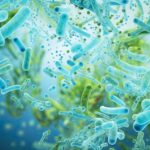• Immune response
• The role of Staphylococci
• Complex interactions
What is already known on this topic
When the skin is injured, our body sets into motion a series of events that include inflammation and tissue repair. However, the events that trigger wound healing are poorly understood.What this research adds
Working in mice, researchers found that bacteria colonizing skin wounds stimulate immune cells to produce an inflammatory molecule called CXCL10, which recruits a rare type of immune cells known as plasmacytoid dendritic cells. CXCL10 also acts as an antimicrobial protein that kills exposed microbiota, leading to the formation of CXCL10-bacterial DNA complexes. These complexes stimulate plasmacytoid dendritic cells to produce a type of inflammatory molecule that accelerates wound closure.Conclusion
The findings reveal a key role of skin microbiota in wound-healing processes and open avenues for the development of microbiota-based therapeutic strategies to improve healing of skin wounds.
When the skin is injured, our body sets into motion a series of events that include inflammation and tissue repair. But the events that trigger wound healing are poorly understood. Now, researchers have found that skin microbes play a key role in wound-healing processes.
The findings, published in Nature Immunology, could open up avenues for the development of microbiota-based therapeutic strategies to improve healing of skin wounds, the researcher say.
To understand the mechanisms that initiate and regulate immune responses in skin wounds, Michel Gilliet at the University of Lausanne and his colleagues studied mice whose outermost skin layer had been removed.
Immune response
The researchers found that, when the mice skin was injured, a type of immune cells produced an inflammatory molecule called CXCL10, which recruited a rare type of immune cells known as plasmacytoid dendritic cells into the wound.
The team confirmed this observation in people by triggering the formation of a blister on the forearm of healthy volunteers. Fluids from blisters collected after 12 hours contained high numbers of immune cells expressing CXCL10 as well as high numbers of plasmacytoid dendritic cells. The levels of CXCL10 were correlated with the number of plasmacytoid dendritic cells.
The team also observed that immune cells accumulated in the injured skin next to clusters of bacteria, suggesting that the cells start to produce CXCL10 only after encountering the skin microbiota.
The role of Staphylococci
To assess whether skin bacteria are responsible for the induction of CXCL10 and the recruitment of plasmacytoid dendritic cells to the wound, the researchers injured the skin of mice that were born and grown in the absence of microbes.
These mice did not produce CXCL10 nor recruit plasmacytoid dendritic cells into the wounds. If skin bacteria including Staphylococcus epidermidis, S. xylosus, and S. saprophiticus were added to the skin of germ-free mice, the animals produced CXCL10 and recruited plasmacytoid dendritic cells to the site of injury.
Complex interactions
Further experiments revealed that CXCL10 also acts as an antimicrobial protein that kills exposed microbiota, leading to the formation of CXCL10-bacterial DNA complexes. These complexes stimulate plasmacytoid dendritic cells to produce inflammatory molecules called type I interferons, which accelerated wound closure by triggering skin inflammation and wound repair responses.
“The finding that skin commensals accelerate wound healing responses has a number of potential clinical implications,” the researchers say. “Because wound management is usually based on principles of reducing bacterial load to prevent infection, this finding should raise caution about the prolonged use of antibiotics and antiseptics in acute skin wounds,” they add.
What’s more, applying beneficial microbes to injured skin could trigger wound healing responses. “Our study therefore sets the basis for the development of therapeutic strategies to improve healing of skin wounds based on modulation of the skin microbiota,” the researchers say.










